Featured Post
- Get link
- X
- Other Apps
Attempting to bring the Electric Vehicles EV to the masses.
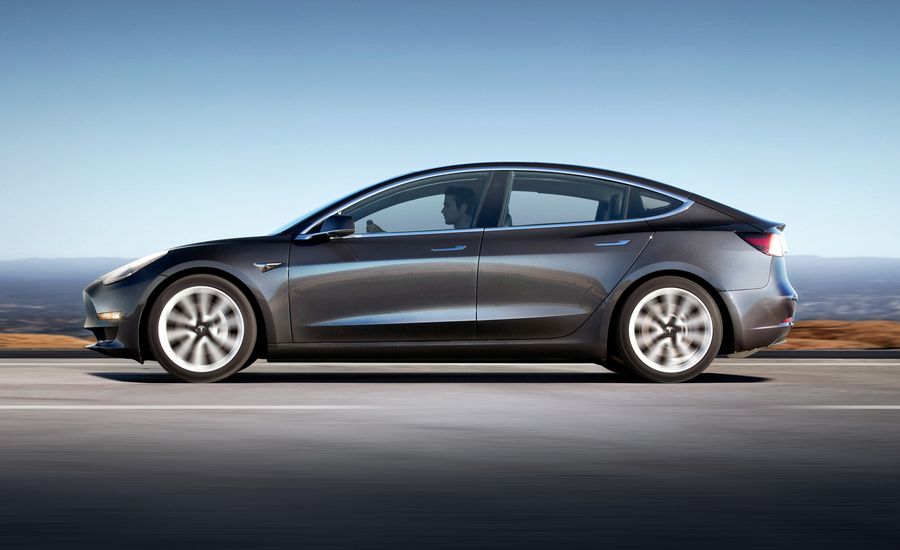
The Tesla Model 3 is one of the most anticipated new vehicles of the decade. While the Model Stransformed how we see electric cars, the Model 3 is supposed to be the one that democratizes them. Tesla conceived the 3 to be simpler and more affordable, and the company hopes to build millions of them.
Now Tesla not only has to build cars at many times the rate it ever has, but it has to deliver them and provide service and support to a far larger, likely less forgiving owner base. The California automaker is now in the early stages of production ramp-up. Follow along as we run through the vitals on the Model 3, look at why it has created such a buzz, and try to make some sense of it all. Look for regular updates here as the Model 3 story continues to unfold.VIEW 18 PHOTOS
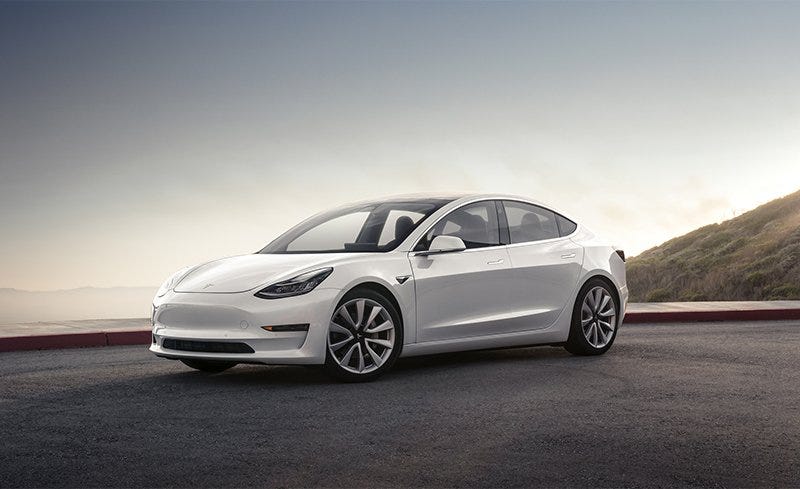
Design
At 184.8 inches long, 72.8 inches wide, and 56.8 inches high, with a 113.2-inch wheelbase, the Model 3 fits right in among an established entry-luxury cohort that includes the BMW 3-series, Mercedes-Benz C-class, and Audi A4. Compared with those German offerings, its appearance is quite different, especially from the front, where it eschews a grille in favor of flush aero work and an especially low snout and hood, with headlamps pulled back and resting more atop the fenders than at the leading edge of the car.
Although its profile closely resembles that of the Model S, which is a hatchback, the Model 3 is a five-passenger sedan with a conventional trunk. That allows one of the most innovative design features in the Model 3: its glass roof, which arcs, uninterrupted, all the way from the trunklid to near the front occupants’ heads. It also eliminates the typical rear-window header and helps maximize headroom in back, while allowing the racier roofline and profile (likely contributing to the Model 3’s claimed 0.23 drag coefficient).
It’s inside, however, where the Model 3 makes a far bigger splash. In what could be an ode to design minimalism, cost cutting, assembly simplification, or a mix thereof, Tesla has purged all gauges as well as some traditional switchgear from the Model 3. There’s no instrument cluster, and the only display is a horizontally oriented 15.0-inch touchscreen—an interface that is not only relied on for basic info such as speed, vehicle status, and the battery’s state of charge but also for entertainment, navigation, climate controls, and settings. If you’re looking for knobs to turn or physical buttons to click, this is not your car.
Powertrain
The Model 3, like the Model S, is a rear-wheel-drive car in its base form, with a rear-mounted AC induction motor. All-wheel-drive versions add a front motor as well as other upgrades including Ludicrous Mode performance. These are expected to become available sometime in the second half of 2018.VIEW 18 PHOTOS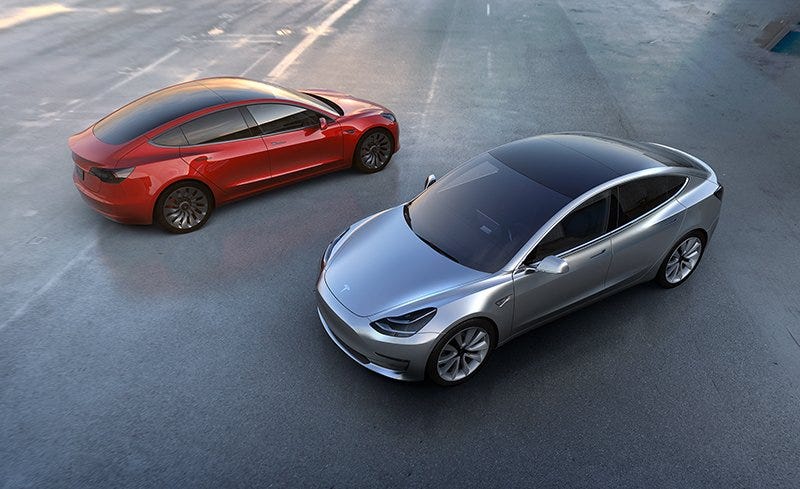
Tesla has not yet specified the capacities in kilowatt-hours of the two available battery packs, and the Model 3 moves to a nomenclature that isn’t centered on the amount of energy storage. For now, there will be two versions: standard and Long Range. The standard version has an EPA-estimated driving range of 220 miles and will accelerate to 60 mph in 5.6 seconds, according to Tesla, while the Long Range version goes 310 miles on a charge and is claimed to make the 60-mph dash in 5.1 seconds. Top speed is listed as 130 mph for the standard Model 3 and 140 mph for the Long Range model.
The Model 3 doesn’t use the same battery technology as the Model S. It uses cells with a new chemistry and format produced by supplier Panasonic. These cells are assembled into the battery pack at Tesla’s Gigafactory in Sparks, Nevada.
Charging
Tesla is the only automaker to have developed its own proprietary network of charging stations, dubbed Superchargers. The company says it is in the process of expanding the number of chargers in North America by 150 percent during 2017, to a total of nearly 6500 at the end of the year. Although the Model 3 is fully compatible with that network, you’ll have to pay incrementally by charging time or by kilowatt-hour (depending on the state) for the use of Tesla’s fastest Superchargers. Using those, the standard version can recover 130 miles in 30 minutes, according to Tesla, while the Long Range version can recover 170 miles in 30 minutes. Tesla vehicles currently charge at a peak of 120 kW, and their onboard charging hardware can handle up to 145 kW—well beyond the 50-kW peak power you’ll find at Level 3 CHAdeMO or CCS (Combo) connections.
Slower Tesla-configured connectors hosted by businesses such as hotels or restaurants—so-called Destination Chargers—remain free to patrons and offer a power level that would bring you a full charge overnight or a partial one in a few hours. Tesla recommends its Wall Connector for the fastest possible home charging, although the company includes a NEMA 14-50 adapter for home charging with 240 volts. Charging time with a depleted battery and a 120-volt power source will be measured in days.VIEW 18 PHOTOS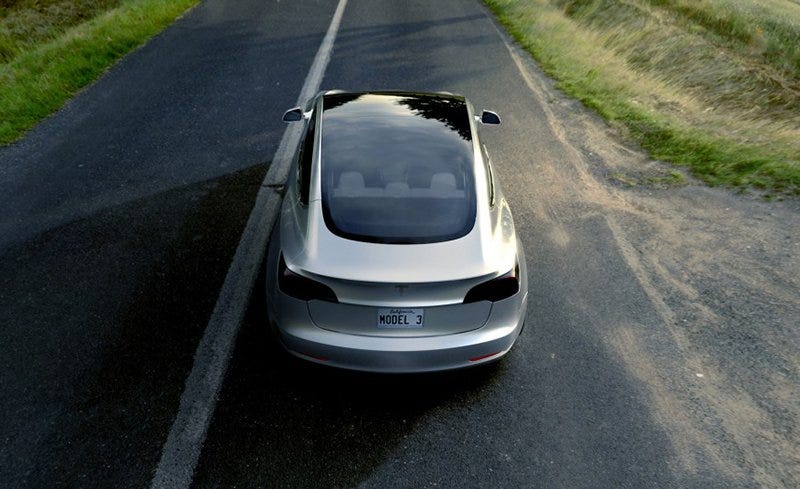
Chassis
The Model 3 was designed as a smaller, stripped-down version of the Model S in some respects, yet it was engineered with completely different underpinnings with the intention of lowering cost and easing mass production. That includes a scaled-down body structure made of aluminum and high-strength steel (instead of all aluminum, as in the Models S and X) and a total curb weight that isn’t much more than those of rival compact sports sedans: 3550 pounds in base form or 3850 for the Long Range, by our estimation.
With the rear-wheel-drive layout, a low center of gravity due to its underfloor battery pack, and 53 percent of its weight on the rear wheels (for the base version; 52 percent for the Long Range model), the Model 3 has the potential for excellent driving dynamics. The suspension consists of multilink geometry front and rear, along with anti-roll bars at both ends. The steering is a variable-ratio, speed-sensitive system, and Tesla will offer a choice of 18-inch Aero or 19-inch Sport wheels. In a very brief drive—we’re talking 10 minutes—the Model 3 seemed zippy and responsive, although further impressions will have to wait until we get more time in the driver’s seat.
Functionality
The Model 3’s interior, with its all-touchscreen interface—with which we’ve yet to spend significant time—is dramatically different from anything else on the market. That contrasts with the rest of the cabin, which is more warm and welcoming in a traditional sense and was clearly designed to be functional for commuters and families by including door pockets, storage cubbies, and cupholders.
There’s room for five in the Model 3, officially. Although we’re not sure how much of the packaging might have changed from the prototype that Tesla showed in March 2016 (the front seats look quite a bit different, for instance), we verified at that time that the prototype could easily fit two six-footers, one behind the other, which would make the Model 3 at least as accommodating as many sedans its size.VIEW 18 PHOTOS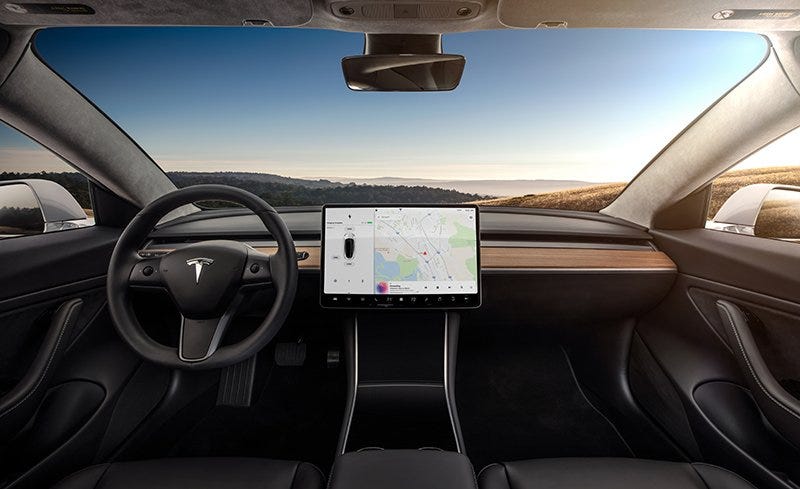
The Model 3 offers 15 cubic feet of cargo space, divvied up between the front cargo area and the rear trunk. The rear seats are split 60/40 and will fold forward flat (or nearly so), creating a long, continuous space. That said, the small trunk opening still won’t make the Model 3 a preferred vehicle for big-box errands.
Pricing and Features
Tesla has stuck to a $36,200 base price for the Model 3 (the promised $35,000 plus a $1200 destination charge), while the base price of the Long Range version starts at $45,200. That undercuts the Chevrolet Bolt EV ($37,495) and the BMW i3 ($43,395) and is just $1755 more, in standard form, than a base BMW 320i.
Both versions of the Model 3 pack in quite a bit of standard equipment, which we’d call fully competitive on a feature basis with other luxury-brand sedans in this price range. Dual-zone climate control, onboard navigation, Wi-Fi and LTE connectivity, FM/Internet radio, voice controls, a backup camera, and power windows and mirrors are all included. Safety equipment includes eight cameras, 12 ultrasonic sensors, and forward radar, all of which enables a suite of active-safety features, plus six front-row airbags and two side-curtain bags. The 19-inch Sport wheels are a $1500 option, and all colors but black cost $1000 extra.
The Model 3 has one traditional luxury option group, called the Premium Upgrades package. For $5000, it adds distinctive open-pore wood trim, heated seats, upgraded cabin materials, higher-grade audio, auto-dimming heated and power-folding side mirrors, saved driver profiles, two rear USB ports, a center console with covered storage and docking space for two smartphones, plus power-adjustable front seats, steering column, and side mirrors. The package also adds LED foglamps and a tinted glass roof with UV and infrared protection. For another $5000 you can add Enhanced Autopilot: Besides matching your speed to traffic conditions, it will follow your travel lane, automatically change lanes in some conditions, exit the freeway, and self-park. With that option, Tesla plans to roll out Autopilot features and enhancements in the future, and beyond this, Tesla eventually plans to offer a Full Self-Driving Capability option for another $3000—which, when offered, would push a fully optioned car past the $60,000 mark.VIEW 18 PHOTOS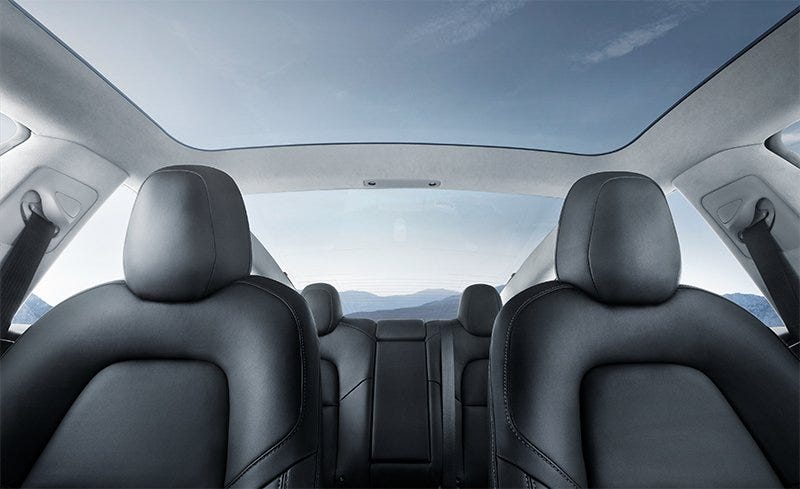
The federal $7500 EV tax credit will apply for the time being, although Tesla is expected to hit its ceiling of 200,000 vehicles eligible for the credit in 2018. That means those currently placing a reservation shouldn’t count on getting the credit—or at least not the full amount, as it phases out incrementally. Nine states have their own rebates or credits that will further reduce the cost. In California and Oregon, for instance, with tax-credit eligibility, the base car would effectively cost just $26,200.
Phone as Car Key
Tesla has done away with traditional keys or fobs in the Model 3. Using a Bluetooth Low Energy connection, the car authenticates its owner via smartphone, unlocks, and powers up. What if you don’t have a phone with you (or its battery is dead) or you want to have a valet park the car? There’s a card that uses near-field-communication (NFC) technology. A tap of the card at the side pillar will lock or unlock the vehicle.
Stores, Not Dealerships
The Model 3 will prove to be an important test of Tesla’s retail network, which depends not on the traditional model of franchised dealerships but on factory stores and service depots. Owners can make service appointments from their cars or smartphones, but Tesla’s company-owned retail stores—modeled after those of Apple—are the contact points for shoppers thinking about a purchase or learning about features or upgrades. Tesla thinks this model is the future, but it has met a lot of resistance, and some states, including Texas and Michigan, still don’t permit Tesla stores under their franchising laws. That creates some odd logistical workarounds for people in those states who want to buy any Tesla.
Serviceability
Tesla so far remains the only automaker that does over-the-air updates of core vehicle-system software, that we know of. Simply put, one day you might notice an additional feature or even realize that your Tesla drives somewhat differently (or that it’s quicker). Since Tesla doesn’t have traditional dealerships, the brand relies heavily on remote diagnostics and support from mobile technicians—who may decide to take your car off to a service center.VIEW 18 PHOTOS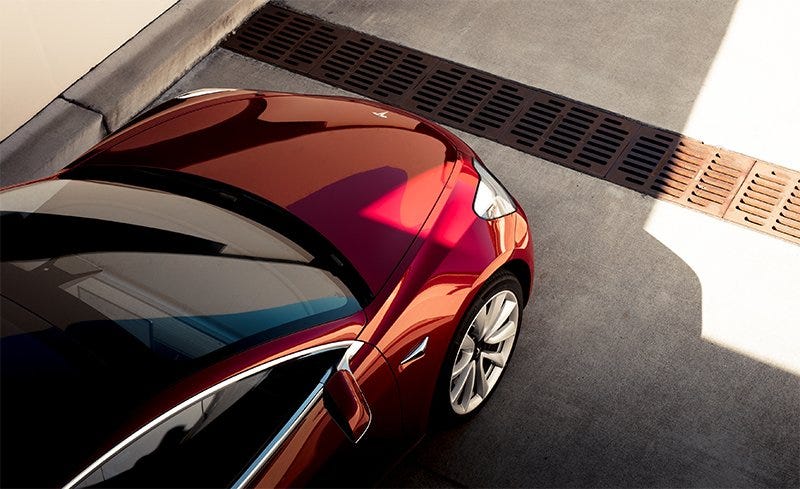
In preparation for the Model 3, Tesla said it is adding about 100 service centers and 1400 technicians. Although the company claims to have reduced repair times by 35 percent just this year, Tesla’s vision of how it is better off without franchise dealerships will be tested the first time the automaker faces a major recall.
Tesla hasn’t yet detailed the regular service schedule for the Model 3, but CEO Elon Musk said recently that the Model 3 powertrain is designed to go about a million miles without service.
Reservations
Tesla has taken more than 500,000 money-down reservations for the Model 3 to date—all accomplished without conventional marketing. The company received 276,000 reservations in the first three days they could be placed, and in the week after the reveal the total was already up to 325,000.
These $1000 (fully refundable) commitments ensure a place in the delivery queue—although it’s not completely chronological, because Tesla is making the first deliveries to employees and prioritizing current Tesla owners. Buyers in the Eastern United States may have to wait longer than those in California and in West Coast states.VIEW 18 PHOTOS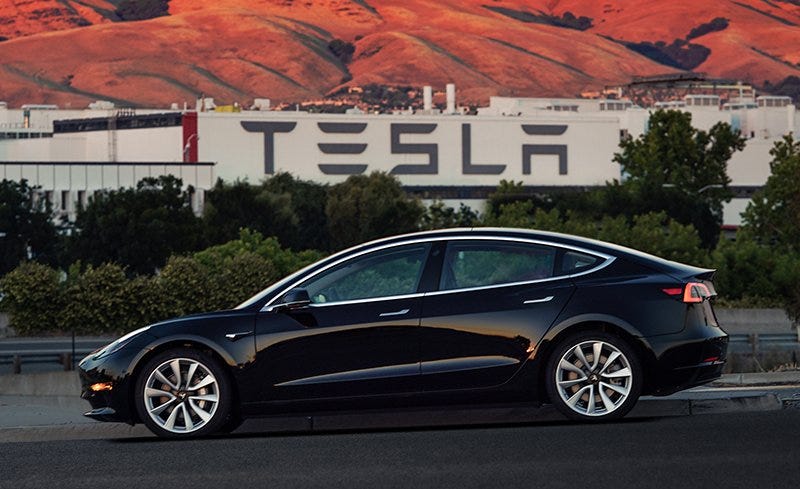
CEO Musk has mused that Tesla has been in effect, “antiselling” the Model 3. The automaker has been careful to emphasize that the Model S will remain the flagship car in the lineup—with a much, much shorter wait time.
Availability
Initially, Tesla is ramping up production of one well-equipped build of the Model 3—in Long Range form, equipped with every currently available option and carrying a likely sticker price of $57,700. Deliveries of the Model 3 with the standard battery are due to start in October. Other versions, including those with all-wheel drive, may be offered starting next year.
Musk, at the recent event delivering the first production vehicles, warned of impending “production hell”—as Tesla attempts to ramp up production to 5000 cars per week (20,000 per month) by the end of 2017. Tesla has long targeted a production rate of 500,000 Model 3s per year, to be reached in 2018, and a rate of a million vehicles annually (20,000 per week) in 2020. To get there, the automaker is counting on payoff from a massive investment in assembly robotics—with complexity that Musk likened to an alien dreadnought.VIEW 18 PHOTOS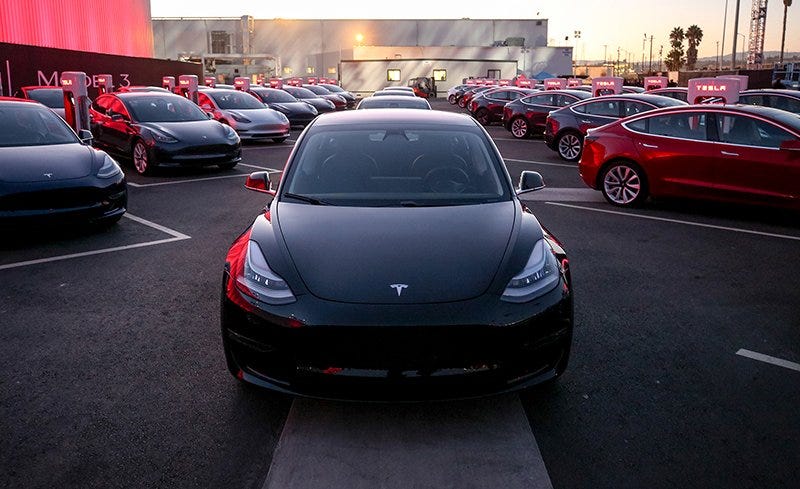
Given the 500,000-plus people in line, those who put down deposits today aren’t expected to see delivery until late 2018—if Tesla doesn’t run into production slowdowns. Musk has hedged the production-rate goals by saying that any natural disaster or hitch with its suppliers might slow the ramp-up rate even more. As of August 1, 2017, Tesla has delivered only 30 vehicles to employees and none yet to the general public.
The Elon Factor
Between SpaceX, Hyperloop, SolarCity, Neuralink, and even the Boring Company, the supervillain/superhero mystique and rocket-scientist pedigree of Tesla’s CEO, Elon Musk, has a lot to do with the company’s survival and success—and, many might say, why it’s overhyped and overvalued on Wall Street. Musk is active on Twitter and often engages fans and Tesla owners. At times he’s rolled out small product changes because of requests or criticisms heard via social media—something that would almost certainly be preceded by months of clinics and surveys at other automakers.
Source: BENGT HALVORSON - Car and Driver

The Tesla Model 3 is one of the most anticipated new vehicles of the decade. While the Model Stransformed how we see electric cars, the Model 3 is supposed to be the one that democratizes them. Tesla conceived the 3 to be simpler and more affordable, and the company hopes to build millions of them.
Now Tesla not only has to build cars at many times the rate it ever has, but it has to deliver them and provide service and support to a far larger, likely less forgiving owner base. The California automaker is now in the early stages of production ramp-up. Follow along as we run through the vitals on the Model 3, look at why it has created such a buzz, and try to make some sense of it all. Look for regular updates here as the Model 3 story continues to unfold.VIEW 18 PHOTOS

Design
At 184.8 inches long, 72.8 inches wide, and 56.8 inches high, with a 113.2-inch wheelbase, the Model 3 fits right in among an established entry-luxury cohort that includes the BMW 3-series, Mercedes-Benz C-class, and Audi A4. Compared with those German offerings, its appearance is quite different, especially from the front, where it eschews a grille in favor of flush aero work and an especially low snout and hood, with headlamps pulled back and resting more atop the fenders than at the leading edge of the car.
Although its profile closely resembles that of the Model S, which is a hatchback, the Model 3 is a five-passenger sedan with a conventional trunk. That allows one of the most innovative design features in the Model 3: its glass roof, which arcs, uninterrupted, all the way from the trunklid to near the front occupants’ heads. It also eliminates the typical rear-window header and helps maximize headroom in back, while allowing the racier roofline and profile (likely contributing to the Model 3’s claimed 0.23 drag coefficient).
It’s inside, however, where the Model 3 makes a far bigger splash. In what could be an ode to design minimalism, cost cutting, assembly simplification, or a mix thereof, Tesla has purged all gauges as well as some traditional switchgear from the Model 3. There’s no instrument cluster, and the only display is a horizontally oriented 15.0-inch touchscreen—an interface that is not only relied on for basic info such as speed, vehicle status, and the battery’s state of charge but also for entertainment, navigation, climate controls, and settings. If you’re looking for knobs to turn or physical buttons to click, this is not your car.
Powertrain
The Model 3, like the Model S, is a rear-wheel-drive car in its base form, with a rear-mounted AC induction motor. All-wheel-drive versions add a front motor as well as other upgrades including Ludicrous Mode performance. These are expected to become available sometime in the second half of 2018.VIEW 18 PHOTOS

Tesla has not yet specified the capacities in kilowatt-hours of the two available battery packs, and the Model 3 moves to a nomenclature that isn’t centered on the amount of energy storage. For now, there will be two versions: standard and Long Range. The standard version has an EPA-estimated driving range of 220 miles and will accelerate to 60 mph in 5.6 seconds, according to Tesla, while the Long Range version goes 310 miles on a charge and is claimed to make the 60-mph dash in 5.1 seconds. Top speed is listed as 130 mph for the standard Model 3 and 140 mph for the Long Range model.
The Model 3 doesn’t use the same battery technology as the Model S. It uses cells with a new chemistry and format produced by supplier Panasonic. These cells are assembled into the battery pack at Tesla’s Gigafactory in Sparks, Nevada.
Charging
Tesla is the only automaker to have developed its own proprietary network of charging stations, dubbed Superchargers. The company says it is in the process of expanding the number of chargers in North America by 150 percent during 2017, to a total of nearly 6500 at the end of the year. Although the Model 3 is fully compatible with that network, you’ll have to pay incrementally by charging time or by kilowatt-hour (depending on the state) for the use of Tesla’s fastest Superchargers. Using those, the standard version can recover 130 miles in 30 minutes, according to Tesla, while the Long Range version can recover 170 miles in 30 minutes. Tesla vehicles currently charge at a peak of 120 kW, and their onboard charging hardware can handle up to 145 kW—well beyond the 50-kW peak power you’ll find at Level 3 CHAdeMO or CCS (Combo) connections.
Slower Tesla-configured connectors hosted by businesses such as hotels or restaurants—so-called Destination Chargers—remain free to patrons and offer a power level that would bring you a full charge overnight or a partial one in a few hours. Tesla recommends its Wall Connector for the fastest possible home charging, although the company includes a NEMA 14-50 adapter for home charging with 240 volts. Charging time with a depleted battery and a 120-volt power source will be measured in days.VIEW 18 PHOTOS

Chassis
The Model 3 was designed as a smaller, stripped-down version of the Model S in some respects, yet it was engineered with completely different underpinnings with the intention of lowering cost and easing mass production. That includes a scaled-down body structure made of aluminum and high-strength steel (instead of all aluminum, as in the Models S and X) and a total curb weight that isn’t much more than those of rival compact sports sedans: 3550 pounds in base form or 3850 for the Long Range, by our estimation.
With the rear-wheel-drive layout, a low center of gravity due to its underfloor battery pack, and 53 percent of its weight on the rear wheels (for the base version; 52 percent for the Long Range model), the Model 3 has the potential for excellent driving dynamics. The suspension consists of multilink geometry front and rear, along with anti-roll bars at both ends. The steering is a variable-ratio, speed-sensitive system, and Tesla will offer a choice of 18-inch Aero or 19-inch Sport wheels. In a very brief drive—we’re talking 10 minutes—the Model 3 seemed zippy and responsive, although further impressions will have to wait until we get more time in the driver’s seat.
Functionality
The Model 3’s interior, with its all-touchscreen interface—with which we’ve yet to spend significant time—is dramatically different from anything else on the market. That contrasts with the rest of the cabin, which is more warm and welcoming in a traditional sense and was clearly designed to be functional for commuters and families by including door pockets, storage cubbies, and cupholders.
There’s room for five in the Model 3, officially. Although we’re not sure how much of the packaging might have changed from the prototype that Tesla showed in March 2016 (the front seats look quite a bit different, for instance), we verified at that time that the prototype could easily fit two six-footers, one behind the other, which would make the Model 3 at least as accommodating as many sedans its size.VIEW 18 PHOTOS

The Model 3 offers 15 cubic feet of cargo space, divvied up between the front cargo area and the rear trunk. The rear seats are split 60/40 and will fold forward flat (or nearly so), creating a long, continuous space. That said, the small trunk opening still won’t make the Model 3 a preferred vehicle for big-box errands.
Pricing and Features
Tesla has stuck to a $36,200 base price for the Model 3 (the promised $35,000 plus a $1200 destination charge), while the base price of the Long Range version starts at $45,200. That undercuts the Chevrolet Bolt EV ($37,495) and the BMW i3 ($43,395) and is just $1755 more, in standard form, than a base BMW 320i.
Both versions of the Model 3 pack in quite a bit of standard equipment, which we’d call fully competitive on a feature basis with other luxury-brand sedans in this price range. Dual-zone climate control, onboard navigation, Wi-Fi and LTE connectivity, FM/Internet radio, voice controls, a backup camera, and power windows and mirrors are all included. Safety equipment includes eight cameras, 12 ultrasonic sensors, and forward radar, all of which enables a suite of active-safety features, plus six front-row airbags and two side-curtain bags. The 19-inch Sport wheels are a $1500 option, and all colors but black cost $1000 extra.
The Model 3 has one traditional luxury option group, called the Premium Upgrades package. For $5000, it adds distinctive open-pore wood trim, heated seats, upgraded cabin materials, higher-grade audio, auto-dimming heated and power-folding side mirrors, saved driver profiles, two rear USB ports, a center console with covered storage and docking space for two smartphones, plus power-adjustable front seats, steering column, and side mirrors. The package also adds LED foglamps and a tinted glass roof with UV and infrared protection. For another $5000 you can add Enhanced Autopilot: Besides matching your speed to traffic conditions, it will follow your travel lane, automatically change lanes in some conditions, exit the freeway, and self-park. With that option, Tesla plans to roll out Autopilot features and enhancements in the future, and beyond this, Tesla eventually plans to offer a Full Self-Driving Capability option for another $3000—which, when offered, would push a fully optioned car past the $60,000 mark.VIEW 18 PHOTOS

The federal $7500 EV tax credit will apply for the time being, although Tesla is expected to hit its ceiling of 200,000 vehicles eligible for the credit in 2018. That means those currently placing a reservation shouldn’t count on getting the credit—or at least not the full amount, as it phases out incrementally. Nine states have their own rebates or credits that will further reduce the cost. In California and Oregon, for instance, with tax-credit eligibility, the base car would effectively cost just $26,200.
Phone as Car Key
Tesla has done away with traditional keys or fobs in the Model 3. Using a Bluetooth Low Energy connection, the car authenticates its owner via smartphone, unlocks, and powers up. What if you don’t have a phone with you (or its battery is dead) or you want to have a valet park the car? There’s a card that uses near-field-communication (NFC) technology. A tap of the card at the side pillar will lock or unlock the vehicle.
Stores, Not Dealerships
The Model 3 will prove to be an important test of Tesla’s retail network, which depends not on the traditional model of franchised dealerships but on factory stores and service depots. Owners can make service appointments from their cars or smartphones, but Tesla’s company-owned retail stores—modeled after those of Apple—are the contact points for shoppers thinking about a purchase or learning about features or upgrades. Tesla thinks this model is the future, but it has met a lot of resistance, and some states, including Texas and Michigan, still don’t permit Tesla stores under their franchising laws. That creates some odd logistical workarounds for people in those states who want to buy any Tesla.
Serviceability
Tesla so far remains the only automaker that does over-the-air updates of core vehicle-system software, that we know of. Simply put, one day you might notice an additional feature or even realize that your Tesla drives somewhat differently (or that it’s quicker). Since Tesla doesn’t have traditional dealerships, the brand relies heavily on remote diagnostics and support from mobile technicians—who may decide to take your car off to a service center.VIEW 18 PHOTOS

In preparation for the Model 3, Tesla said it is adding about 100 service centers and 1400 technicians. Although the company claims to have reduced repair times by 35 percent just this year, Tesla’s vision of how it is better off without franchise dealerships will be tested the first time the automaker faces a major recall.
Tesla hasn’t yet detailed the regular service schedule for the Model 3, but CEO Elon Musk said recently that the Model 3 powertrain is designed to go about a million miles without service.
Reservations
Tesla has taken more than 500,000 money-down reservations for the Model 3 to date—all accomplished without conventional marketing. The company received 276,000 reservations in the first three days they could be placed, and in the week after the reveal the total was already up to 325,000.
These $1000 (fully refundable) commitments ensure a place in the delivery queue—although it’s not completely chronological, because Tesla is making the first deliveries to employees and prioritizing current Tesla owners. Buyers in the Eastern United States may have to wait longer than those in California and in West Coast states.VIEW 18 PHOTOS

CEO Musk has mused that Tesla has been in effect, “antiselling” the Model 3. The automaker has been careful to emphasize that the Model S will remain the flagship car in the lineup—with a much, much shorter wait time.
Availability
Initially, Tesla is ramping up production of one well-equipped build of the Model 3—in Long Range form, equipped with every currently available option and carrying a likely sticker price of $57,700. Deliveries of the Model 3 with the standard battery are due to start in October. Other versions, including those with all-wheel drive, may be offered starting next year.
Musk, at the recent event delivering the first production vehicles, warned of impending “production hell”—as Tesla attempts to ramp up production to 5000 cars per week (20,000 per month) by the end of 2017. Tesla has long targeted a production rate of 500,000 Model 3s per year, to be reached in 2018, and a rate of a million vehicles annually (20,000 per week) in 2020. To get there, the automaker is counting on payoff from a massive investment in assembly robotics—with complexity that Musk likened to an alien dreadnought.VIEW 18 PHOTOS

Given the 500,000-plus people in line, those who put down deposits today aren’t expected to see delivery until late 2018—if Tesla doesn’t run into production slowdowns. Musk has hedged the production-rate goals by saying that any natural disaster or hitch with its suppliers might slow the ramp-up rate even more. As of August 1, 2017, Tesla has delivered only 30 vehicles to employees and none yet to the general public.
The Elon Factor
Between SpaceX, Hyperloop, SolarCity, Neuralink, and even the Boring Company, the supervillain/superhero mystique and rocket-scientist pedigree of Tesla’s CEO, Elon Musk, has a lot to do with the company’s survival and success—and, many might say, why it’s overhyped and overvalued on Wall Street. Musk is active on Twitter and often engages fans and Tesla owners. At times he’s rolled out small product changes because of requests or criticisms heard via social media—something that would almost certainly be preceded by months of clinics and surveys at other automakers.
Source: BENGT HALVORSON - Car and Driver
Comments